ABS TOYOTA AURIS 2015 Owners Manual (in English)
[x] Cancel search | Manufacturer: TOYOTA, Model Year: 2015, Model line: AURIS, Model: TOYOTA AURIS 2015Pages: 632, PDF Size: 17.65 MB
Page 71 of 632
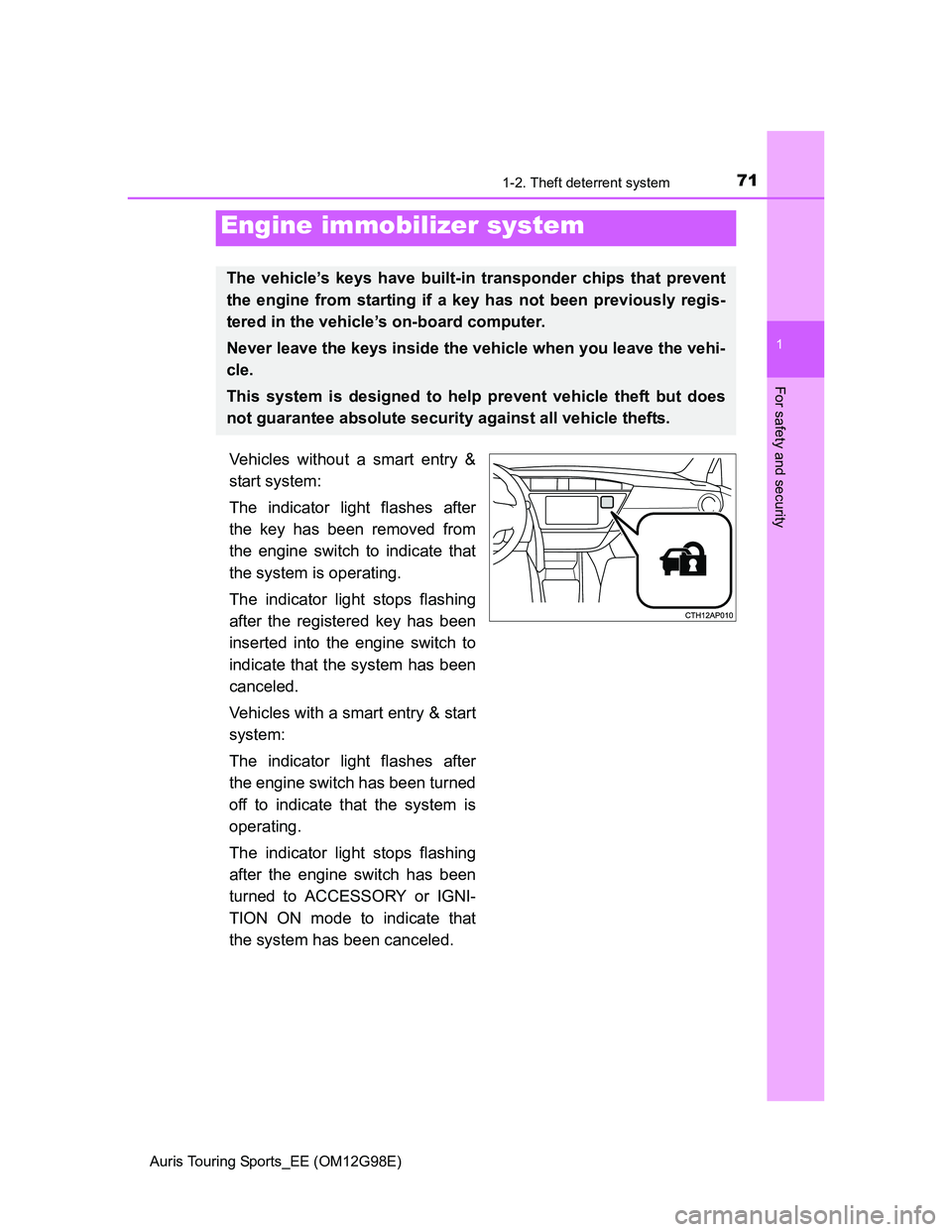
71
1
For safety and security
Auris Touring Sports_EE (OM12G98E)
1-2. Theft deterrent system
Vehicles without a smart entry &
start system:
The indicator light flashes after
the key has been removed from
the engine switch to indicate that
the system is operating.
The indicator light stops flashing
after the registered key has been
inserted into the engine switch to
indicate that the system has been
canceled.
Vehicles with a smart entry & start
system:
The indicator light flashes after
the engine switch has been turned
off to indicate that the system is
operating.
The indicator light stops flashing
after the engine switch has been
turned to ACCESSORY or IGNI-
TION ON mode to indicate that
the system has been canceled.
Engine immobilizer system
The vehicle’s keys have built-in transponder chips that prevent
the engine from starting if a key has not been previously regis-
tered in the vehicle’s on-board computer.
Never leave the keys inside the vehicle when you leave the vehi-
cle.
This system is designed to help prevent vehicle theft but does
not guarantee absolute security against all vehicle thefts.
Page 86 of 632
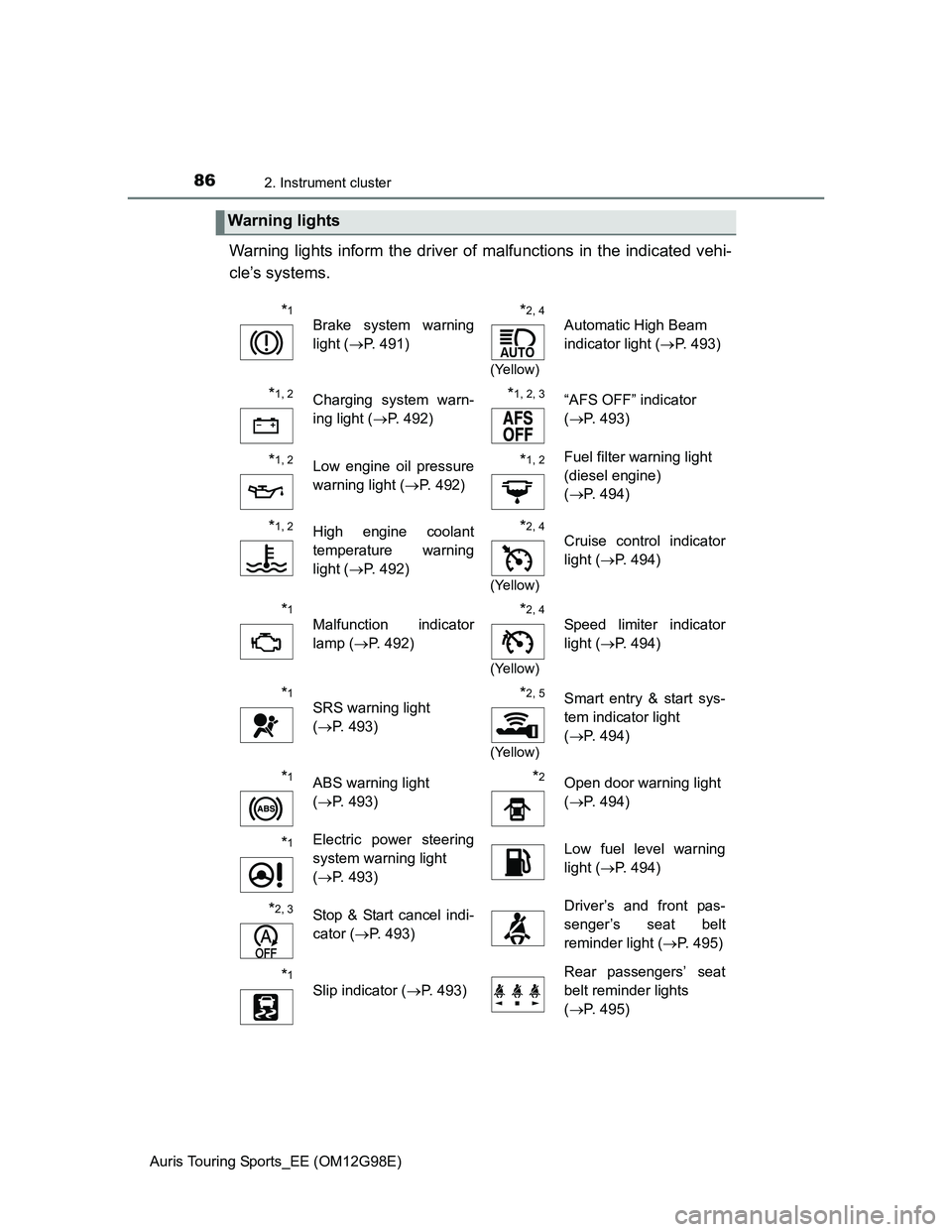
862. Instrument cluster
Auris Touring Sports_EE (OM12G98E)
Warning lights inform the driver of malfunctions in the indicated vehi-
cle’s systems.
Warning lights
*1
Brake system warning
light (P. 491)*2, 4
(Yellow)
Automatic High Beam
indicator light (P. 493)
*1, 2Charging system warn-
ing light (P. 492)*1, 2, 3 “AFS OFF” indicator
(P. 493)
*1, 2Low engine oil pressure
warning light (P. 492)*1, 2Fuel filter warning light
(diesel engine)
(P. 494)
*1, 2High engine coolant
temperature warning
light (P. 492)*2, 4
(Yellow)
Cruise control indicator
light (P. 494)
*1
Malfunction indicator
lamp (P. 492)*2, 4
(Yellow)
Speed limiter indicator
light (P. 494)
*1
SRS warning light
(P. 493)*2, 5
(Yellow)
Smart entry & start sys-
tem indicator light
(P. 494)
*1ABS warning light
(P. 493)*2Open door warning light
(P. 494)
*1Electric power steering
system warning light
(P. 493)Low fuel level warning
light (P. 494)
*2, 3Stop & Start cancel indi-
cator (P. 493)Driver’s and front pas-
senger’s seat belt
reminder light (P. 495)
*1
Slip indicator (P. 493)
Rear passengers’ seat
belt reminder lights
(P. 495)
Page 89 of 632
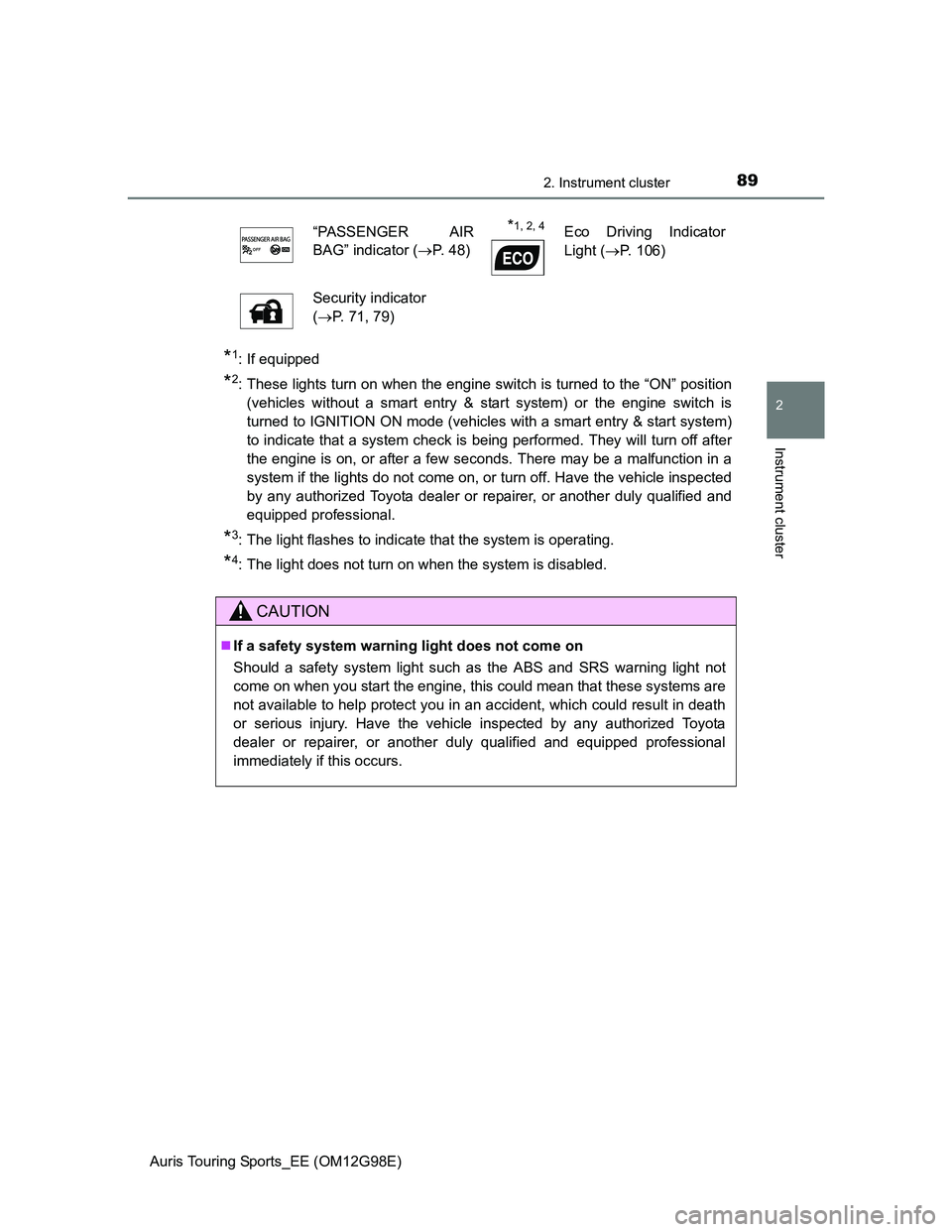
892. Instrument cluster
Auris Touring Sports_EE (OM12G98E)
2
Instrument cluster
*1: If equipped
*2: These lights turn on when the engine switch is turned to the “ON” position
(vehicles without a smart entry & start system) or the engine switch is
turned to IGNITION ON mode (vehicles with a smart entry & start system)
to indicate that a system check is being performed. They will turn off after
the engine is on, or after a few seconds. There may be a malfunction in a
system if the lights do not come on, or turn off. Have the vehicle inspected
by any authorized Toyota dealer or repairer, or another duly qualified and
equipped professional.
*3: The light flashes to indicate that the system is operating.
*4: The light does not turn on when the system is disabled.“PASSENGER AIR
BAG” indicator (P. 48)
*1, 2, 4Eco Driving Indicator
Light (P. 106)
Security indicator
(P. 71, 79)
CAUTION
If a safety system warning light does not come on
Should a safety system light such as the ABS and SRS warning light not
come on when you start the engine, this could mean that these systems are
not available to help protect you in an accident, which could result in death
or serious injury. Have the vehicle inspected by any authorized Toyota
dealer or repairer, or another duly qualified and equipped professional
immediately if this occurs.
Page 254 of 632
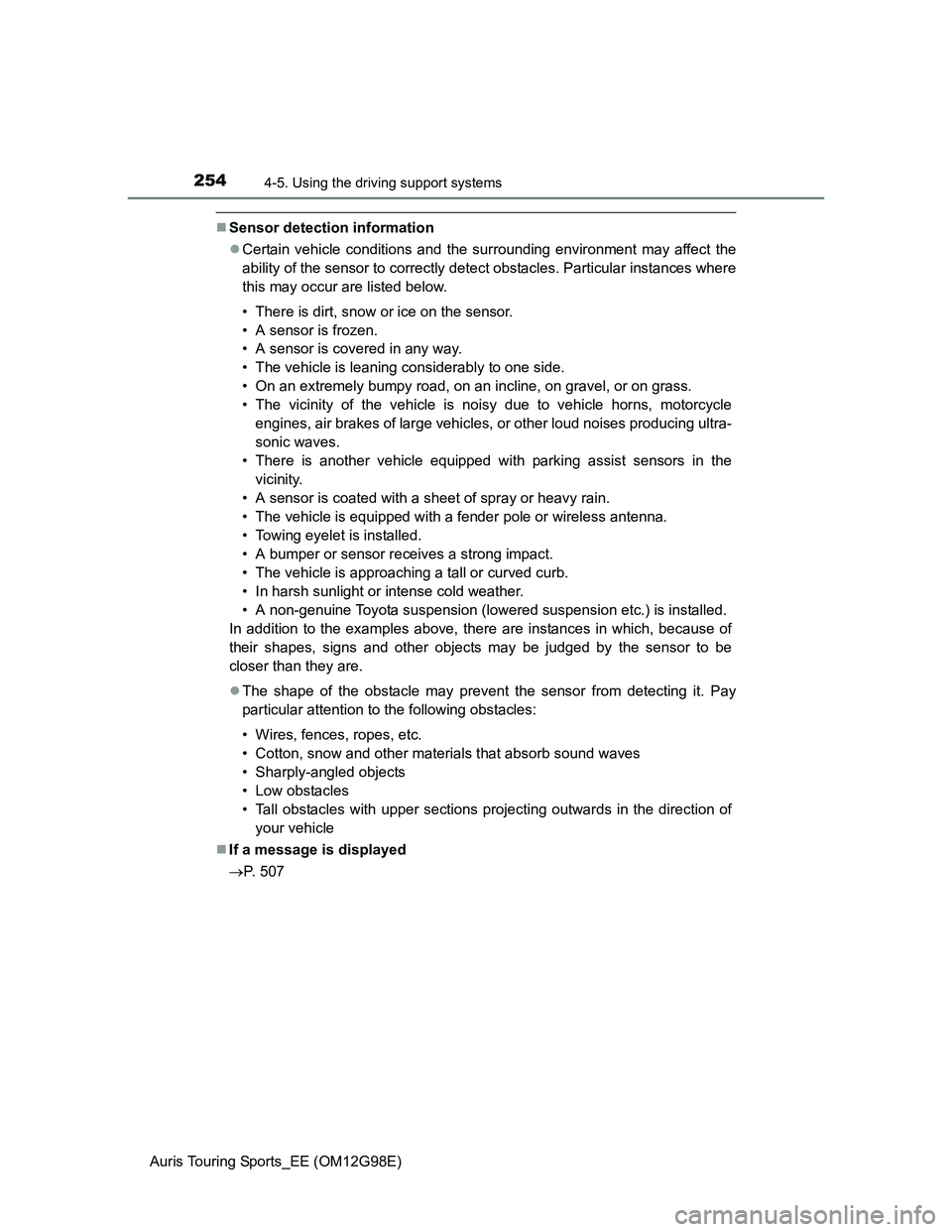
2544-5. Using the driving support systems
Auris Touring Sports_EE (OM12G98E)
Sensor detection information
Certain vehicle conditions and the surrounding environment may affect the
ability of the sensor to correctly detect obstacles. Particular instances where
this may occur are listed below.
• There is dirt, snow or ice on the sensor.
• A sensor is frozen.
• A sensor is covered in any way.
• The vehicle is leaning considerably to one side.
• On an extremely bumpy road, on an incline, on gravel, or on grass.
• The vicinity of the vehicle is noisy due to vehicle horns, motorcycle
engines, air brakes of large vehicles, or other loud noises producing ultra-
sonic waves.
• There is another vehicle equipped with parking assist sensors in the
vicinity.
• A sensor is coated with a sheet of spray or heavy rain.
• The vehicle is equipped with a fender pole or wireless antenna.
• Towing eyelet is installed.
• A bumper or sensor receives a strong impact.
• The vehicle is approaching a tall or curved curb.
• In harsh sunlight or intense cold weather.
• A non-genuine Toyota suspension (lowered suspension etc.) is installed.
In addition to the examples above, there are instances in which, because of
their shapes, signs and other objects may be judged by the sensor to be
closer than they are.
The shape of the obstacle may prevent the sensor from detecting it. Pay
particular attention to the following obstacles:
• Wires, fences, ropes, etc.
• Cotton, snow and other materials that absorb sound waves
• Sharply-angled objects
• Low obstacles
• Tall obstacles with upper sections projecting outwards in the direction of
your vehicle
If a message is displayed
P. 507
Page 263 of 632
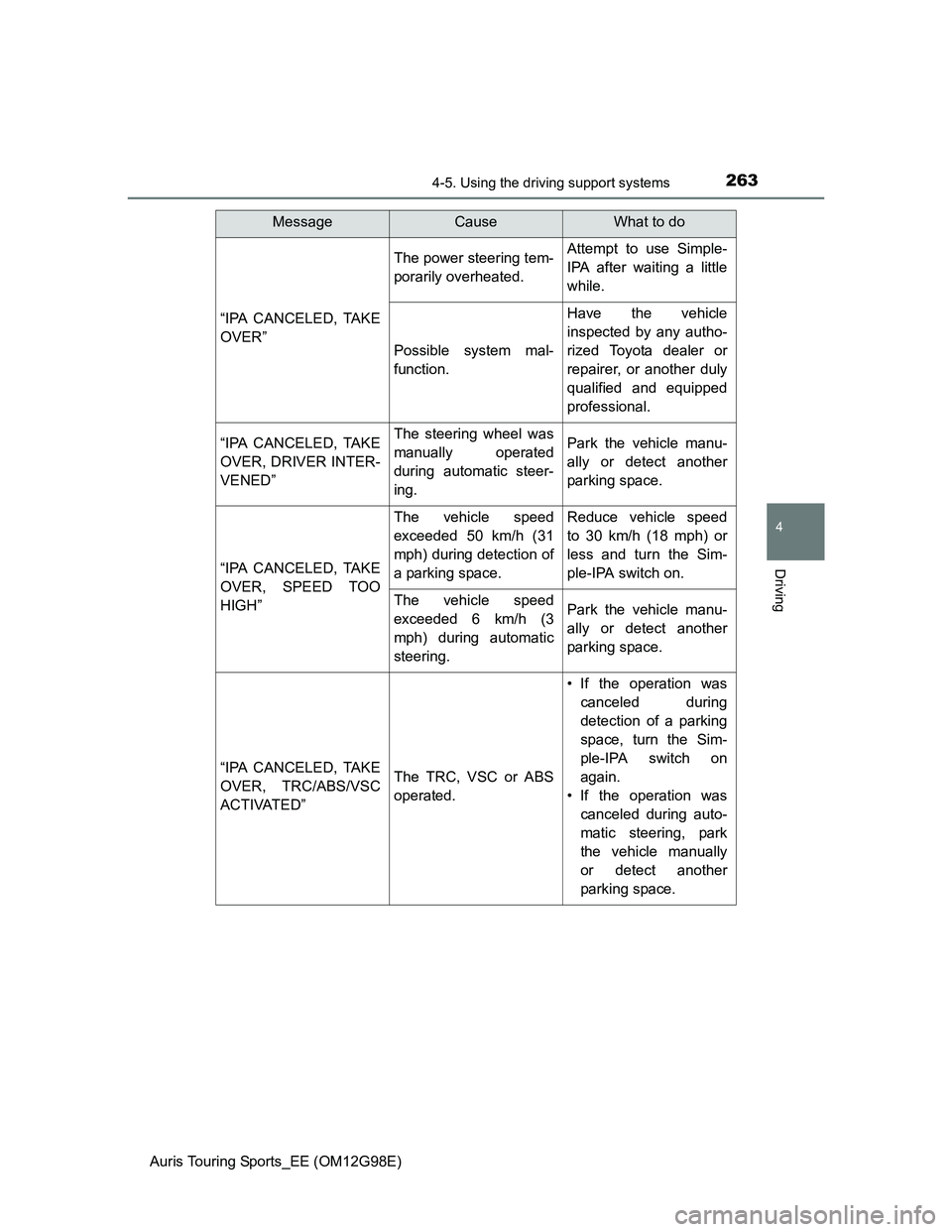
2634-5. Using the driving support systems
Auris Touring Sports_EE (OM12G98E)
4
Driving
“IPA CANCELED, TAKE
OVER”
The power steering tem-
porarily overheated.Attempt to use Simple-
IPA after waiting a little
while.
Possible system mal-
function.
Have the vehicle
inspected by any autho-
rized Toyota dealer or
repairer, or another duly
qualified and equipped
professional.
“IPA CANCELED, TAKE
OVER, DRIVER INTER-
VENED”The steering wheel was
manually operated
during automatic steer-
ing.Park the vehicle manu-
ally or detect another
parking space.
“IPA CANCELED, TAKE
OVER, SPEED TOO
HIGH”
The vehicle speed
exceeded 50 km/h (31
mph) during detection of
a parking space.Reduce vehicle speed
to 30 km/h (18 mph) or
less and turn the Sim-
ple-IPA switch on.
The vehicle speed
exceeded 6 km/h (3
mph) during automatic
steering.Park the vehicle manu-
ally or detect another
parking space.
“IPA CANCELED, TAKE
OVER, TRC/ABS/VSC
A C T I VAT E D ”The TRC, VSC or ABS
operated.
• If the operation was
canceled during
detection of a parking
space, turn the Sim-
ple-IPA switch on
again.
• If the operation was
canceled during auto-
matic steering, park
the vehicle manually
or detect another
parking space.
MessageCauseWhat to do
Page 266 of 632
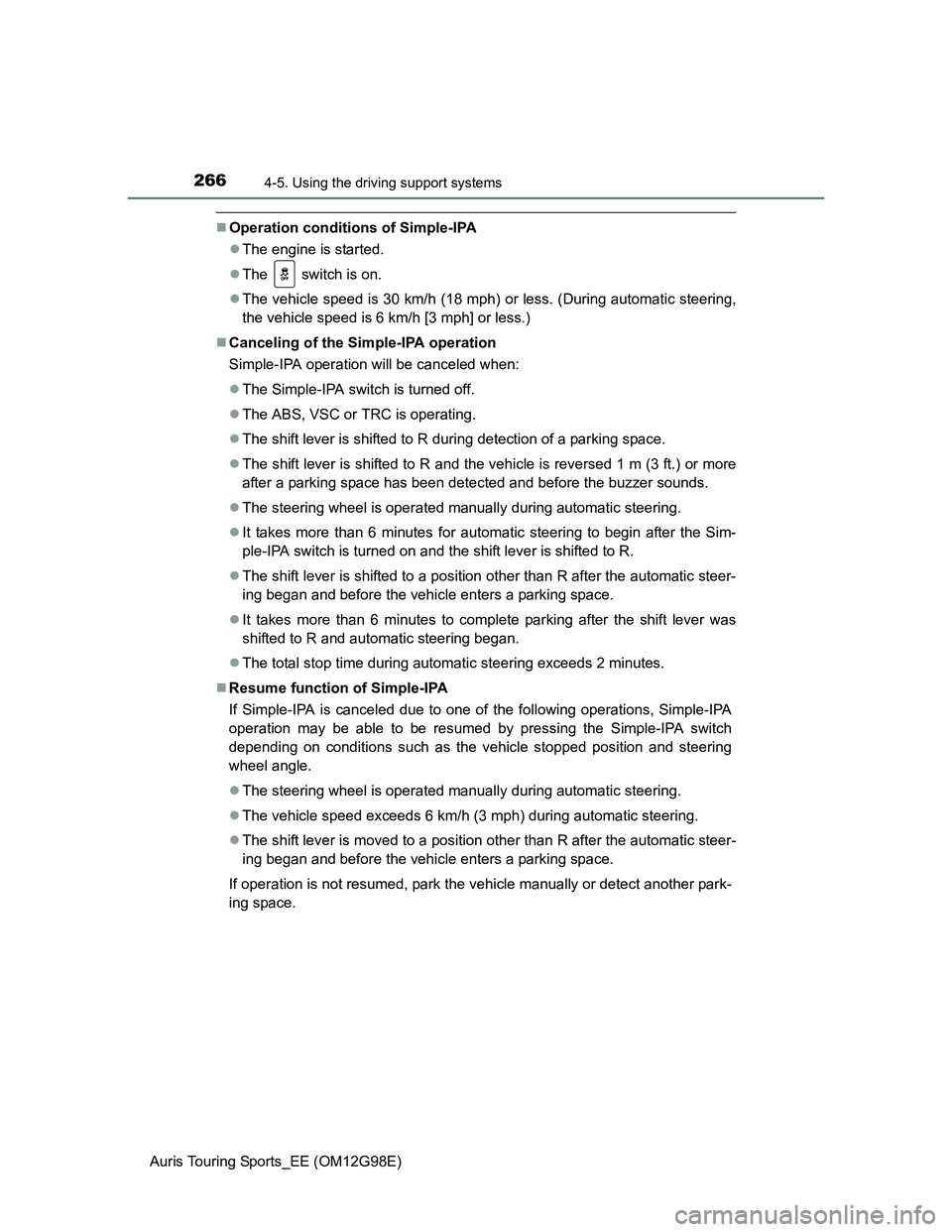
2664-5. Using the driving support systems
Auris Touring Sports_EE (OM12G98E)
Operation conditions of Simple-IPA
The engine is started.
The switch is on.
The vehicle speed is 30 km/h (18 mph) or less. (During automatic steering,
the vehicle speed is 6 km/h [3 mph] or less.)
Canceling of the Simple-IPA operation
Simple-IPA operation will be canceled when:
The Simple-IPA switch is turned off.
The ABS, VSC or TRC is operating.
The shift lever is shifted to R during detection of a parking space.
The shift lever is shifted to R and the vehicle is reversed 1 m (3 ft.) or more
after a parking space has been detected and before the buzzer sounds.
The steering wheel is operated manually during automatic steering.
It takes more than 6 minutes for automatic steering to begin after the Sim-
ple-IPA switch is turned on and the shift lever is shifted to R.
The shift lever is shifted to a position other than R after the automatic steer-
ing began and before the vehicle enters a parking space.
It takes more than 6 minutes to complete parking after the shift lever was
shifted to R and automatic steering began.
The total stop time during automatic steering exceeds 2 minutes.
Resume function of Simple-IPA
If Simple-IPA is canceled due to one of the following operations, Simple-IPA
operation may be able to be resumed by pressing the Simple-IPA switch
depending on conditions such as the vehicle stopped position and steering
wheel angle.
The steering wheel is operated manually during automatic steering.
The vehicle speed exceeds 6 km/h (3 mph) during automatic steering.
The shift lever is moved to a position other than R after the automatic steer-
ing began and before the vehicle enters a parking space.
If operation is not resumed, park the vehicle manually or detect another park-
ing space.
Page 276 of 632
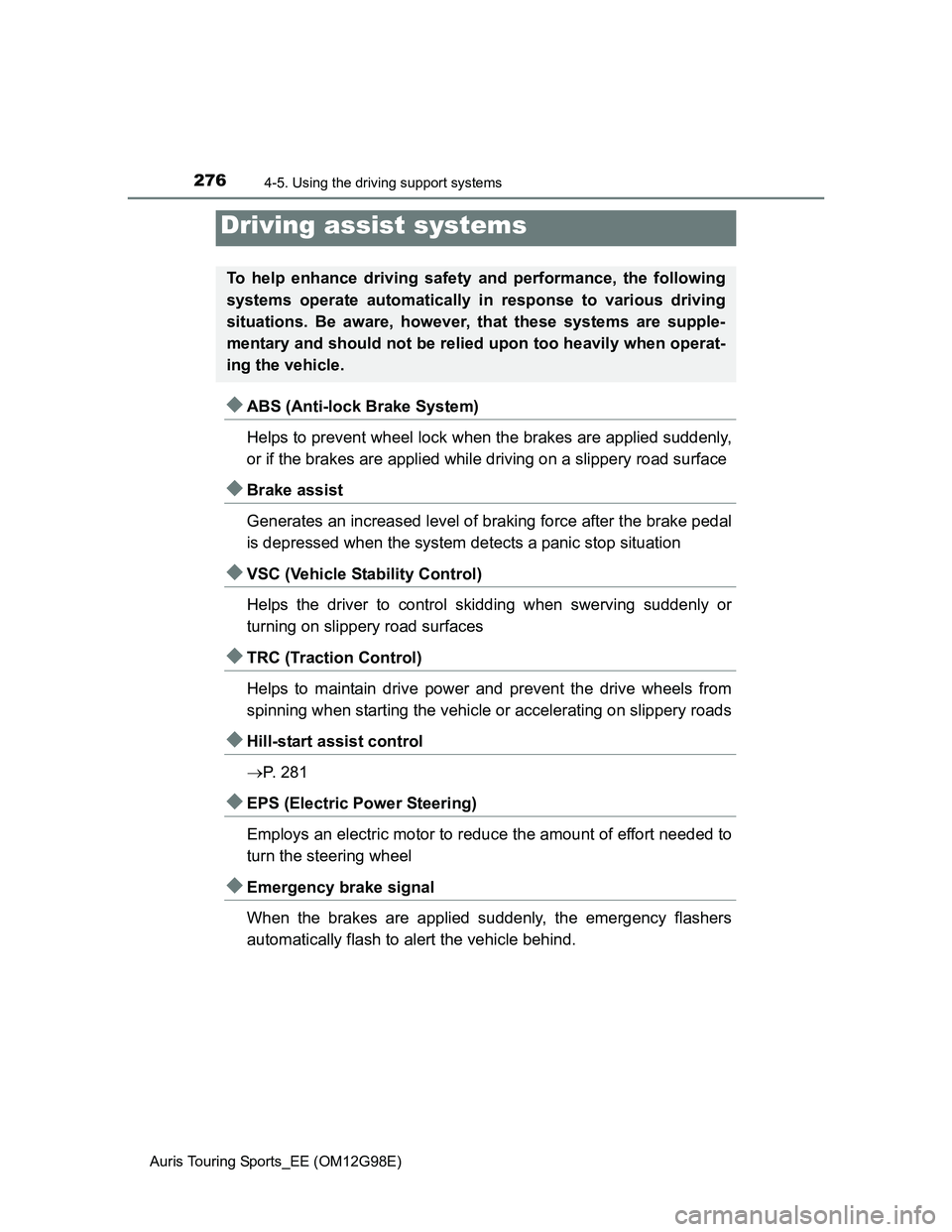
2764-5. Using the driving support systems
Auris Touring Sports_EE (OM12G98E)
ABS (Anti-lock Brake System)
Helps to prevent wheel lock when the brakes are applied suddenly,
or if the brakes are applied while driving on a slippery road surface
Brake assist
Generates an increased level of braking force after the brake pedal
is depressed when the system detects a panic stop situation
VSC (Vehicle Stability Control)
Helps the driver to control skidding when swerving suddenly or
turning on slippery road surfaces
TRC (Traction Control)
Helps to maintain drive power and prevent the drive wheels from
spinning when starting the vehicle or accelerating on slippery roads
Hill-start assist control
P. 2 8 1
EPS (Electric Power Steering)
Employs an electric motor to reduce the amount of effort needed to
turn the steering wheel
Emergency brake signal
When the brakes are applied suddenly, the emergency flashers
automatically flash to alert the vehicle behind.
Driving assist systems
To help enhance driving safety and performance, the following
systems operate automatically in response to various driving
situations. Be aware, however, that these systems are supple-
mentary and should not be relied upon too heavily when operat-
ing the vehicle.
Page 278 of 632
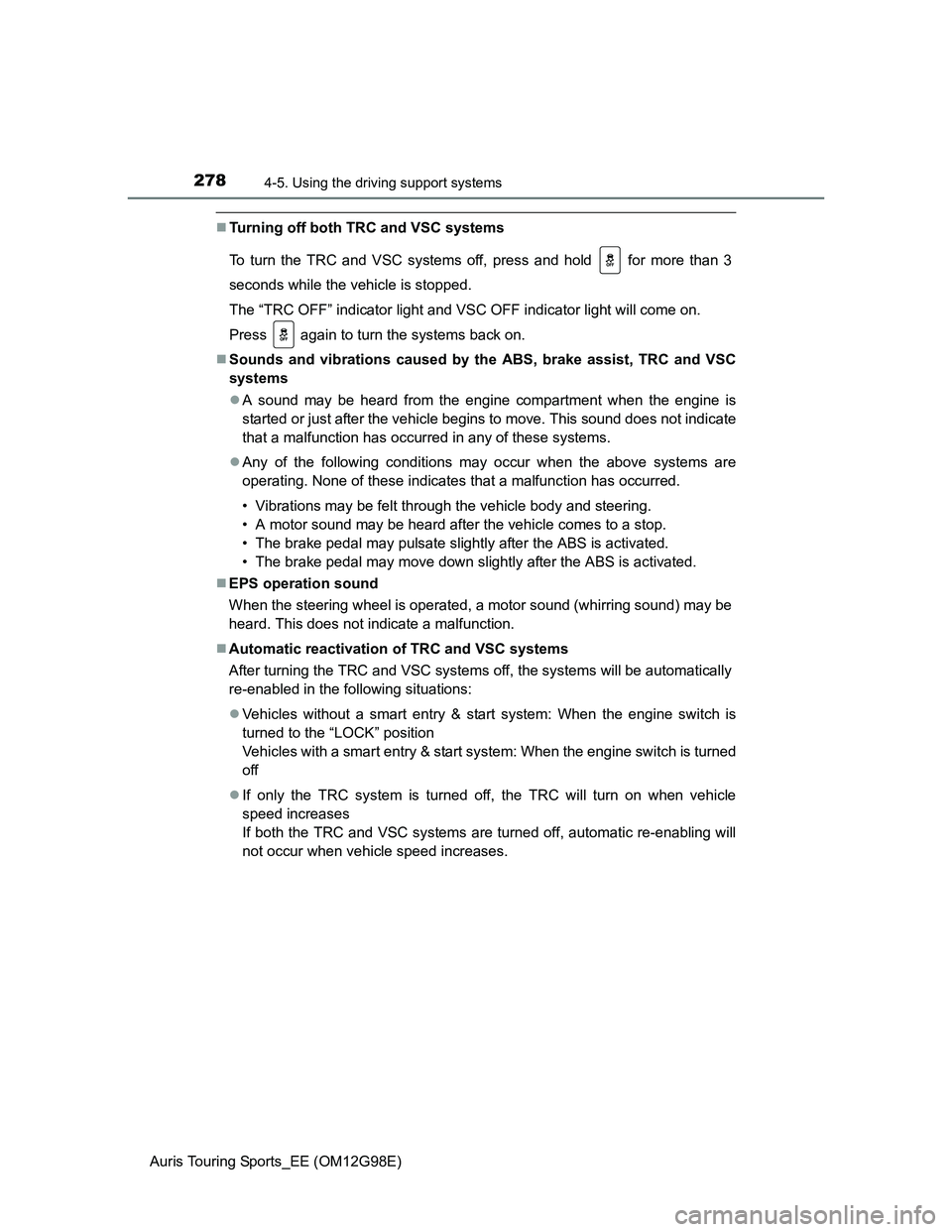
2784-5. Using the driving support systems
Auris Touring Sports_EE (OM12G98E)
Turning off both TRC and VSC systems
To turn the TRC and VSC systems off, press and hold for more than 3
seconds while the vehicle is stopped.
The “TRC OFF” indicator light and VSC OFF indicator light will come on.
Press again to turn the systems back on.
Sounds and vibrations caused by the ABS, brake assist, TRC and VSC
systems
A sound may be heard from the engine compartment when the engine is
started or just after the vehicle begins to move. This sound does not indicate
that a malfunction has occurred in any of these systems.
Any of the following conditions may occur when the above systems are
operating. None of these indicates that a malfunction has occurred.
• Vibrations may be felt through the vehicle body and steering.
• A motor sound may be heard after the vehicle comes to a stop.
• The brake pedal may pulsate slightly after the ABS is activated.
• The brake pedal may move down slightly after the ABS is activated.
EPS operation sound
When the steering wheel is operated, a motor sound (whirring sound) may be
heard. This does not indicate a malfunction.
Automatic reactivation of TRC and VSC systems
After turning the TRC and VSC systems off, the systems will be automatically
re-enabled in the following situations:
Vehicles without a smart entry & start system: When the engine switch is
turned to the “LOCK” position
Vehicles with a smart entry & start system: When the engine switch is turned
off
If only the TRC system is turned off, the TRC will turn on when vehicle
speed increases
If both the TRC and VSC systems are turned off, automatic re-enabling will
not occur when vehicle speed increases.
Page 279 of 632
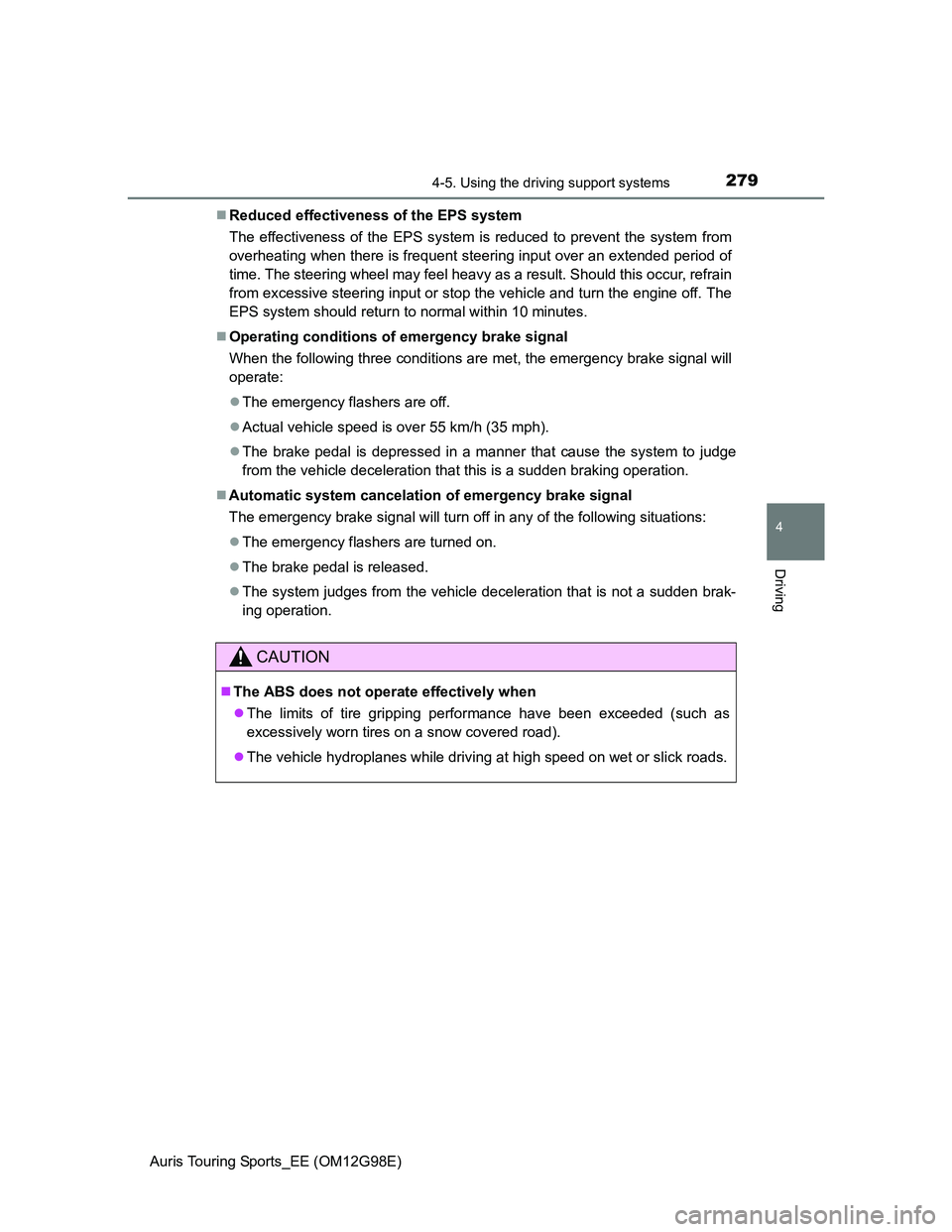
2794-5. Using the driving support systems
Auris Touring Sports_EE (OM12G98E)
4
Driving
Reduced effectiveness of the EPS system
The effectiveness of the EPS system is reduced to prevent the system from
overheating when there is frequent steering input over an extended period of
time. The steering wheel may feel heavy as a result. Should this occur, refrain
from excessive steering input or stop the vehicle and turn the engine off. The
EPS system should return to normal within 10 minutes.
Operating conditions of emergency brake signal
When the following three conditions are met, the emergency brake signal will
operate:
The emergency flashers are off.
Actual vehicle speed is over 55 km/h (35 mph).
The brake pedal is depressed in a manner that cause the system to judge
from the vehicle deceleration that this is a sudden braking operation.
Automatic system cancelation of emergency brake signal
The emergency brake signal will turn off in any of the following situations:
The emergency flashers are turned on.
The brake pedal is released.
The system judges from the vehicle deceleration that is not a sudden brak-
ing operation.
CAUTION
The ABS does not operate effectively when
The limits of tire gripping performance have been exceeded (such as
excessively worn tires on a snow covered road).
The vehicle hydroplanes while driving at high speed on wet or slick roads.
Page 280 of 632
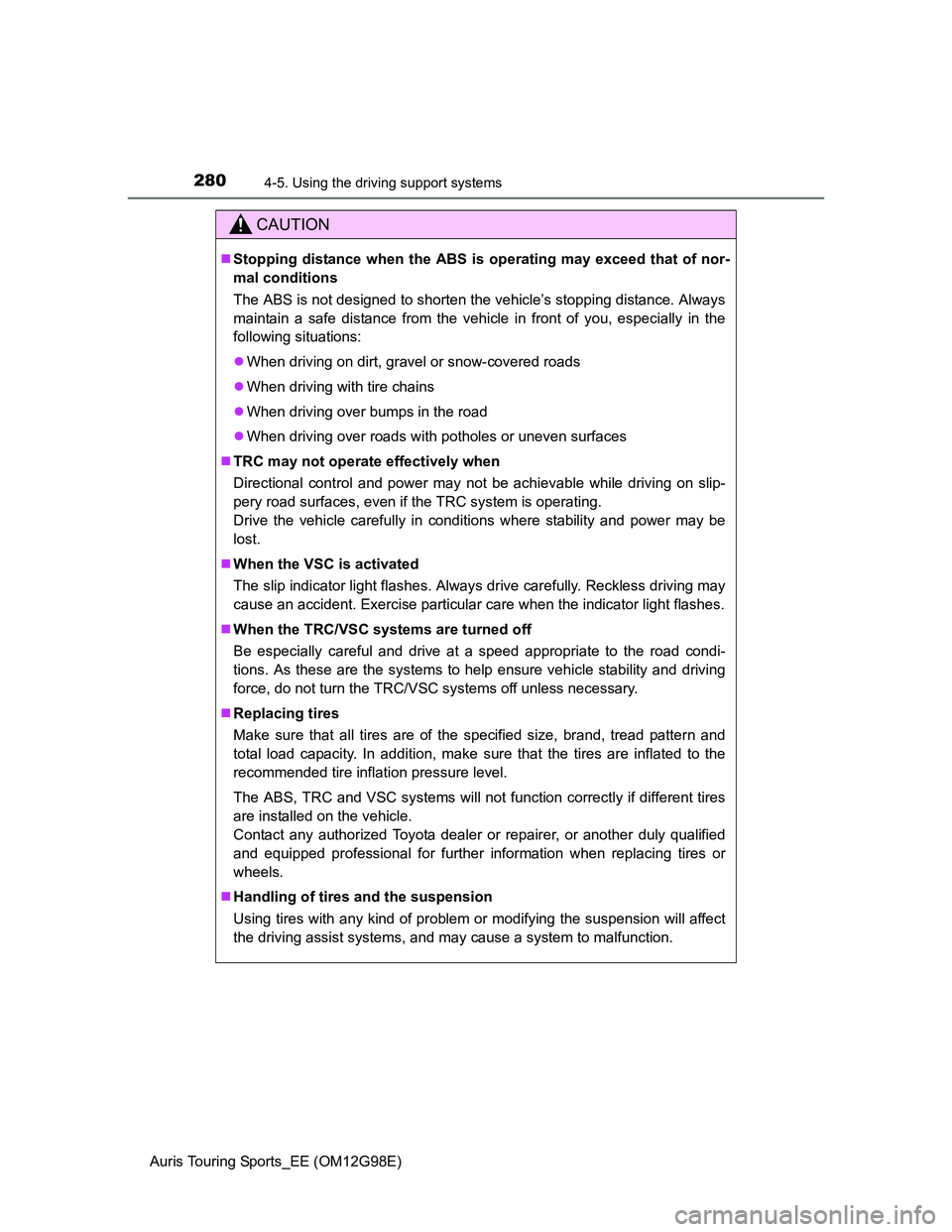
2804-5. Using the driving support systems
Auris Touring Sports_EE (OM12G98E)
CAUTION
Stopping distance when the ABS is operating may exceed that of nor-
mal conditions
The ABS is not designed to shorten the vehicle’s stopping distance. Always
maintain a safe distance from the vehicle in front of you, especially in the
following situations:
When driving on dirt, gravel or snow-covered roads
When driving with tire chains
When driving over bumps in the road
When driving over roads with potholes or uneven surfaces
TRC may not operate effectively when
Directional control and power may not be achievable while driving on slip-
pery road surfaces, even if the TRC system is operating.
Drive the vehicle carefully in conditions where stability and power may be
lost.
When the VSC is activated
The slip indicator light flashes. Always drive carefully. Reckless driving may
cause an accident. Exercise particular care when the indicator light flashes.
When the TRC/VSC systems are turned off
Be especially careful and drive at a speed appropriate to the road condi-
tions. As these are the systems to help ensure vehicle stability and driving
force, do not turn the TRC/VSC systems off unless necessary.
Replacing tires
Make sure that all tires are of the specified size, brand, tread pattern and
total load capacity. In addition, make sure that the tires are inflated to the
recommended tire inflation pressure level.
The ABS, TRC and VSC systems will not function correctly if different tires
are installed on the vehicle.
Contact any authorized Toyota dealer or repairer, or another duly qualified
and equipped professional for further information when replacing tires or
wheels.
Handling of tires and the suspension
Using tires with any kind of problem or modifying the suspension will affect
the driving assist systems, and may cause a system to malfunction.